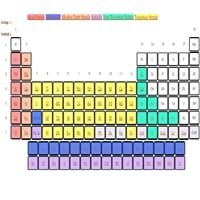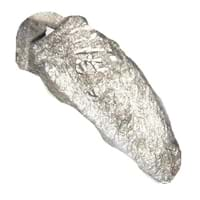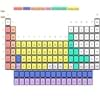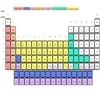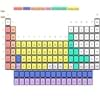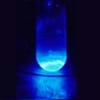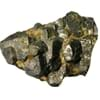Californium vs Europium
Periodic Table
Symbol
Cf
Eu
Group Number
Not Available
Not Available
Period Number
7
6
Block
f block
f block
Element Family
Actinide
Lanthanide
CAS Number
7440713
20
7440531
34
Space Group Name
P63/mmc
Im_ 3m
Space Group Number
194.00
5
229.00
1
Facts
Interesting Facts
- Californium metal is very harmful and highly radioactive.
- Californium metal is the heaviest metal.
Not Available
Sources
Made by Bombarding Curium with Helium Ions
Found in Minerals, Mining, Ores of Minerals
History
Who Discovered
Lawrence Berkeley National Laboratory
Eugène-Anatole Demarçay
Discovery
In 1950
In 1896
Abundance
Abundance In Universe
Not Available
5 * 10-8 %
27
Abundance In Sun
~-9999 %
~0.00000005 %
27
Abundance In Meteorites
Not Available
0.00 %
99+
Abundance In Earth's Crust
Not Available
0.00 %
36
Abundance In Oceans
Not Available
0.00 %
99+
Uses
Uses & Benefits
- Californium metal has a very strong neutron emitter. It is used as a metal detector.
- It also used as an identifier to check Water and oil layers in oil wells.
- Europium metals main uses is in the printing of euro banknotes. These notes glow red under UV light.
- It is used in low energy light bulbs.
Industrial Uses
Chemical Industry
Chemical Industry
Medical Uses
NA
NA
Other Uses
Alloys, Nuclear Research
Alloys
Biological Properties
Toxicity
Toxic
Non Toxic
Present in Human Body
No
Yes
In Blood
0.00 Blood/mg dm-3
37
Not Available
In Bone
0.00 p.p.m.
36
Not Available
Physical Properties
Melting Point
900.00 °C
99+
822.00 °C
99+
Boiling Point
1,470.00 °C
99+
1,597.00 °C
99+
Appearance
Physical State
Solid
Solid
Color
Silver
Silvery White
Luster
NA
Lustrous
Hardness
Mohs Hardness
3.00
12
Not Available
Vickers Hardness
Not Available
167.00 MPa
34
Speed of Sound
Not Available
Not Available
Optical Properties
Allotropes
No
No
α Allotropes
Not Available
Not Available
β Allotropes
Not Available
Not Available
γ Allotropes
Not Available
Not Available
Chemical Properties
Chemical Formula
Cf
Eu
Isotopes
Known Isotopes
20
19
31
8
Electronegativity
Pauling Electronegativity
1.30
32
1.20
39
Sanderson Electronegativity
Not Available
1.01
22
Allred Rochow Electronegativity
1.20
27
Not Available
Electropositivity
Pauling Electropositivity
2.70
22
Not Available
Ionization Energies
1st Energy Level
608.00 kJ/mol
99+
547.10 kJ/mol
99+
2nd Energy Level
1,206.00 kJ/mol
99+
1,085.00 kJ/mol
99+
3rd Energy Level
2,267.00 kJ/mol
99+
2,404.00 kJ/mol
99+
4th Energy Level
3,599.00 kJ/mol
99+
4,120.00 kJ/mol
33
Electrochemical Equivalent
3.12 g/amp-hr
15
1.89 g/amp-hr
33
Electron Work Function
Not Available
2.50 eV
99+
Other Chemical Properties
Corrosion, Ionization, Radioactive Isotopes, Radioactivity, Solubility
Ionization, Radioactive Isotopes, Solubility
Atomic Properties
Atomic Number
98
20
63
99+
Electron Configuration
[Rn] 5f10 7s2
[Xe] 4f7 6s2
Crystal Structure
Double Hexagonal Close Packed (DHCP)
Body Centered Cubic (BCC)
Crystal Lattice
DHCP-Crystal-Structure-of-Californium.jpg#100
BCC-Crystal-Structure-.jpg#100
Atom
Number of Protons
98
20
63
99+
Number of Neutrons
153
9
89
38
Number of Electrons
98
20
63
99+
Radius of an Atom
Atomic Radius
186.00 pm
9
180.00 pm
14
Covalent Radius
Not Available
198.00 pm
13
Van der Waals Radius
Not Available
233.00 pm
18
Atomic Weight
251.00 amu
17
151.96 amu
99+
Atomic Volume
Not Available
28.90 cm3/mol
8
Adjacent Atomic Numbers
Valence Electron Potential
44.50 (-eV)
38
45.60 (-eV)
35
Lattice Constant
338.00 pm
99+
458.10 pm
17
Lattice Angles
π/2, π/2, 2 π/3
π/2, π/2, π/2
Lattice C/A Ratio
Not Available
Not Available
Mechanical Properties
Density
Density At Room Temperature
15.10 g/cm3
21
5.26 g/cm3
99+
Density When Liquid (at m.p.)
Not Available
5.13 g/cm3
99+
Tensile Strength
Not Available
120.00 MPa
15
Viscosity
Not Available
Not Available
Vapor Pressure
Vapor Pressure at 1000 K
Not Available
19.40 (Pa)
4
Elasticity properties
Shear Modulus
Not Available
7.90 GPa
99+
Bulk Modulus
Not Available
8.30 GPa
99+
Young's Modulus
Not Available
18.20 GPa
99+
Poisson Ratio
Not Available
0.15
34
Other Mechanical Properties
Malleable, Sectile
Ductile
Magnetic Properties
Magnetic Characteristics
Specific Gravity
15.10
13
5.24
99+
Magnetic Ordering
Paramagnetic
Paramagnetic
Electrical Properties
Electrical Property
Unknown
Conductor
Resistivity
Not Available
0.90 nΩ·m
99+
Electrical Conductivity
Not Available
0.01 106/cm Ω
99+
Electron Affinity
Not Available
50.00 kJ/mol
21
Thermal Properties
Specific Heat
Not Available
0.18 J/(kg K)
33
Molar Heat Capacity
Not Available
27.66 J/mol·K
16
Thermal Conductivity
Not Available
13.90 W/m·K
99+
Critical Temperature
Not Available
Not Available
Thermal Expansion
Not Available
35.00 µm/(m·K)
8
Enthalpy
Enthalpy of Vaporization
Not Available
143.50 kJ/mol
99+
Enthalpy of Fusion
Not Available
9.21 kJ/mol
37
Enthalpy of Atomization
Not Available
180.00 kJ/mol
99+
Standard Molar Entropy
Not Available
77.80 J/mol.K
4
|
||
|
||
|
